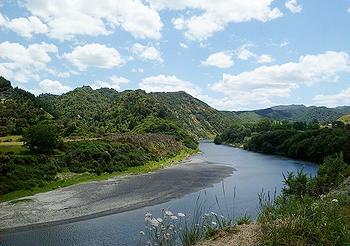 |
| Reviews and Templates for Expression We |
New Zealand’s Whanganui River Gets Personhood Status
Although the agreement does not state specifically that the river will have the same rights under law as a corporation, a spokesman for the government minister of who negotiating the settlement said the Whanganui will be recognized as a person when it comes to the law, “in the same way a company is, which will give it rights and interests.”
Minister Christopher Finlayson said August 30, “This agreement – Tūtohu Whakatupua – is an historic event. Whanganui River iwi have sought to protect the river and have their interests acknowledged by the Crown through the legal system since 1873. They pursued this objective in one of New Zealand’s longest running court cases.”
Whanganui River (Photo by Su Yin Khoo)
“Today’s agreement, which recognizes the status of the river as Te Awa Tupua (an integrated, living whole) and the inextricable relationship of iwi with the river is a major step towards the resolution of the historical grievances of Whanganui Iwi and is important nationally,” Finlayson said.
The agreement does not conclude settlement negotiations. Matters of detail and additional redress are still to be negotiated between the parties, Finlayson said.
The agreements reached so far recognize the status of the river, appoint a river guardian, and provide for developing river values and a whole of river strategy.
Finlayson said these elements of the agreement “advance the goals of Whanganui Iwi while also ensuring the rights of third parties, including private landowners and public access, will continue.”
The parties are working towards the goal of achieving a deed of settlement by the end of the year which will then be the subject of Cabinet approval and ratification by the members of Whanganui Iwi.
The agreement provides for the appointment of two persons, one by the Crown and the other by the River iwi, to a guardianship role to act on behalf of Te Awa Tupua and protect its status and health and wellbeing.
It provides for development of a set of Te Awa Tupua values, that recognize the intrinsic characteristics of the river and will serve to guide decision-makers.
Finally, the agreement enables the development of a “Whole of River Strategy” by collaboration between iwi, central and local governments, commercial and recreational users and other community groups.
The strategy will identify issues for the river, consider ways of addressing them, and recommend actions. The goal of the strategy will be to ensure the long-term environmental, social, cultural and economic health and wellbeing of the river.
New Zealand’s longest navigable river, the Whanganui arises on the northern slopes of Mount Tongariro, one of the three active volcanoes of the central plateau, and close to Lake Rotoaira.
It extends for 290 kilometers (180 miles), reaching the coast at Whanganui, where it flows into the Taranki Bight between New Zealand’s North and South islands, an extension of the Tasman Sea.
The river is of special and spiritual importance for Māori, who call it Te Awa Tupua. In pre-European times, many Māori villages dotted the river banks.
The Whanganui has been one of the most fiercely contested regions in claims before the Waitangi Tribunal for the return of tribal lands. The Whanganui River claim is the longest-running legal case in New Zealand history with petitions and court action since the 1930s.
The Whanganui River National Park was created in 1986 and as part of the string of facilities they provided along the river, the Department of Conservation built a large hut at Tieke.
In 1993, Te Whanau o Tieke Māori occupied the hut, arguing that the land was never alienated from them. With consultation between the parties, there is greater harmony now. While the land is still formally disputed, the Department of Conservation and the Te Whanau o Tieke Māori have developed a co-operative relationship, working together to upgrade and maintain visitor facilities at Tieke.
|
|
|
|
Copyright 2011 Energy and Technical Services Ltd. All Rights Reserved. Energyts.com |